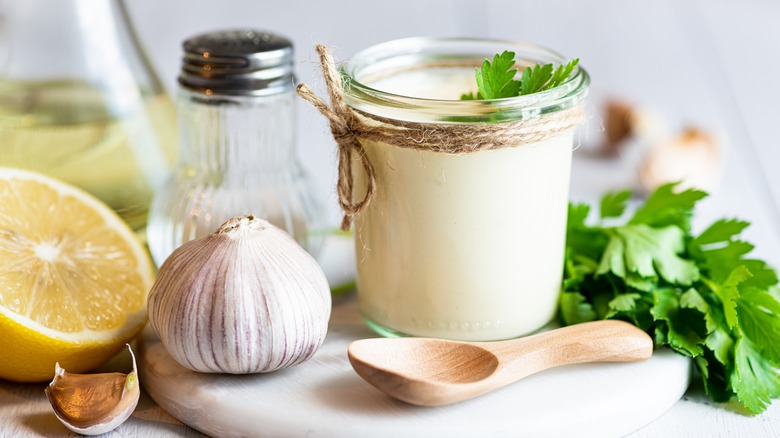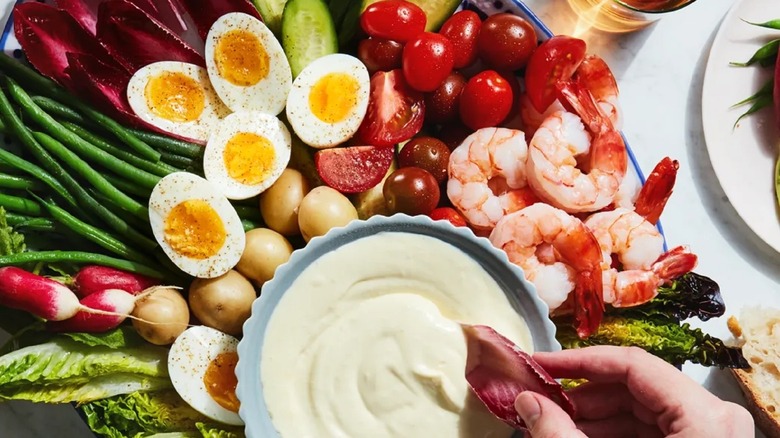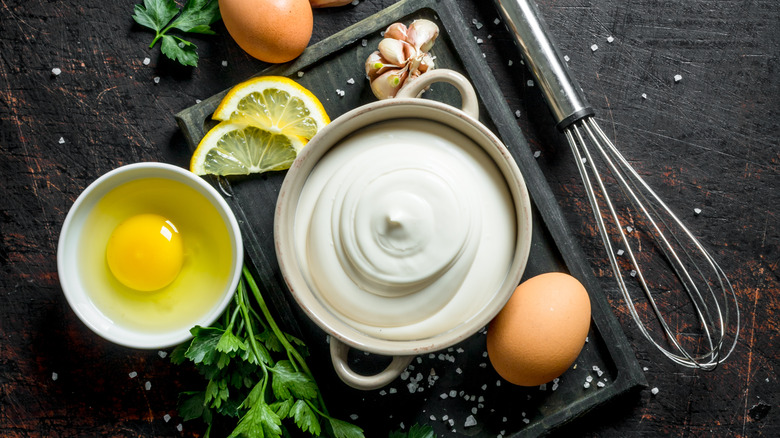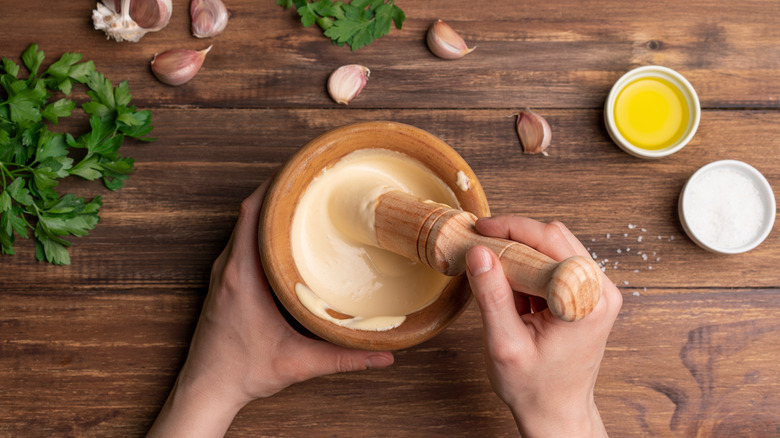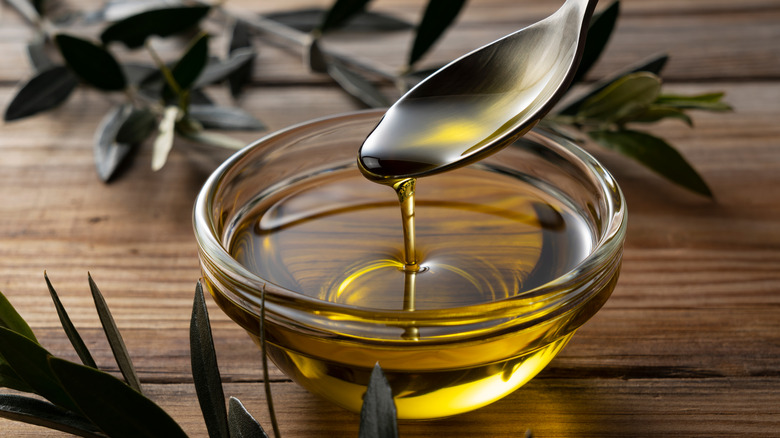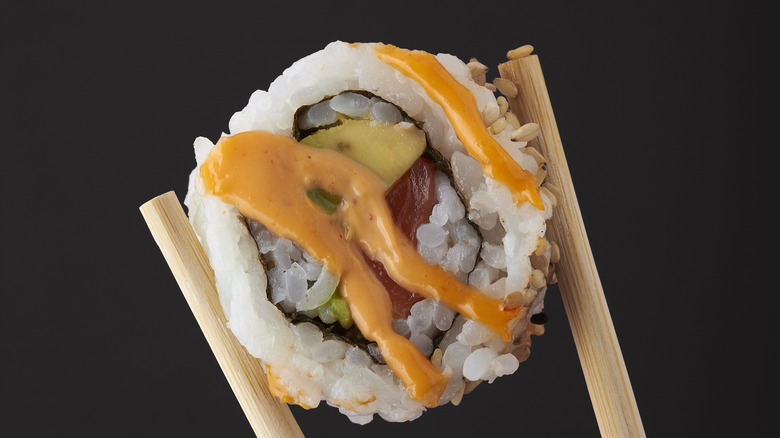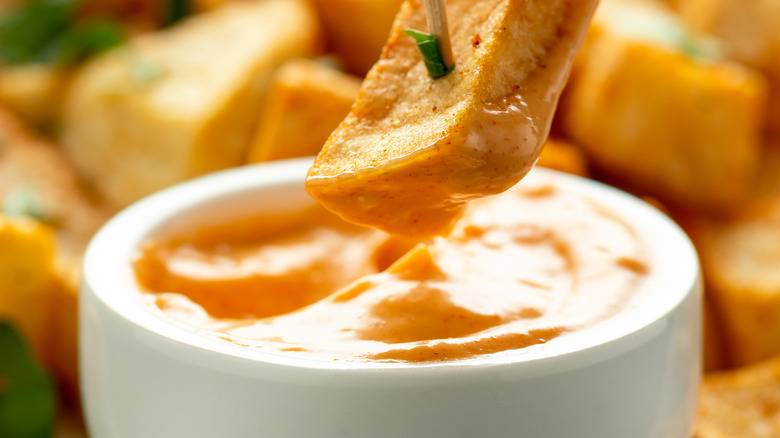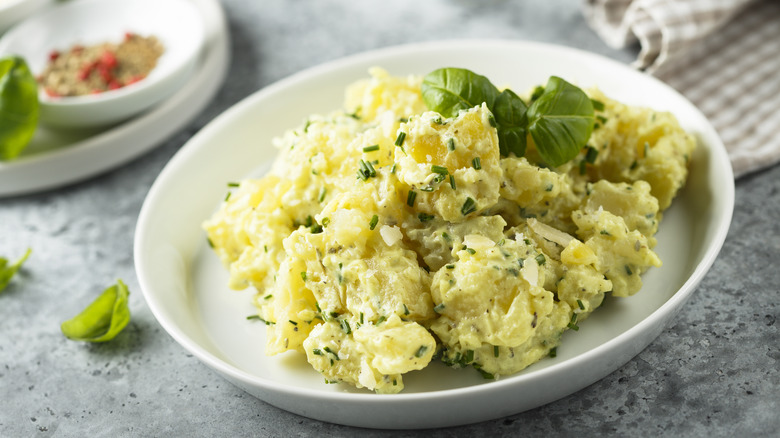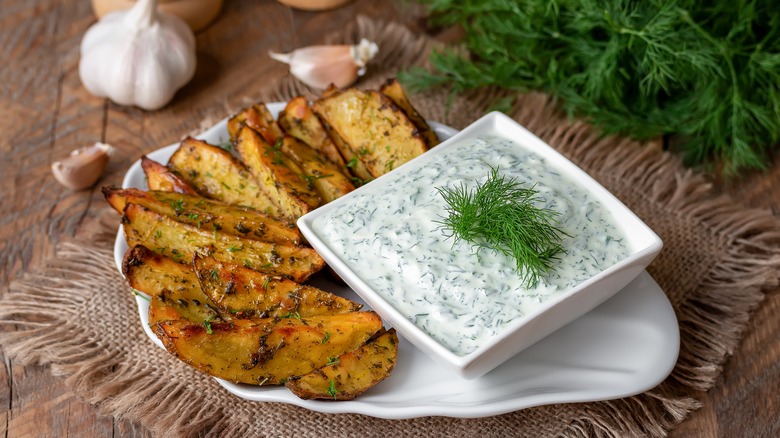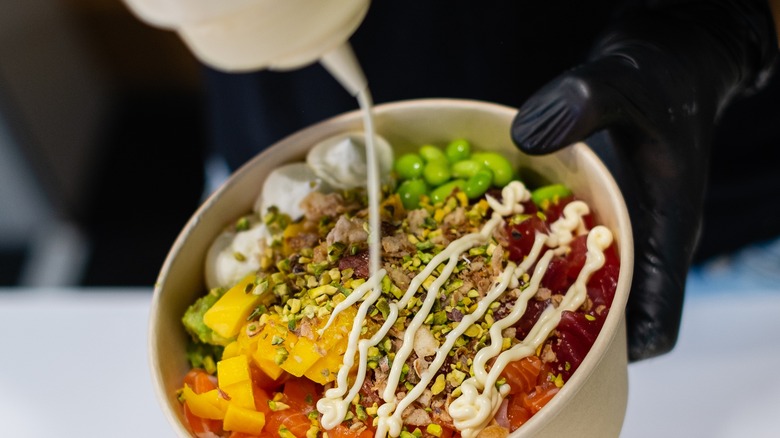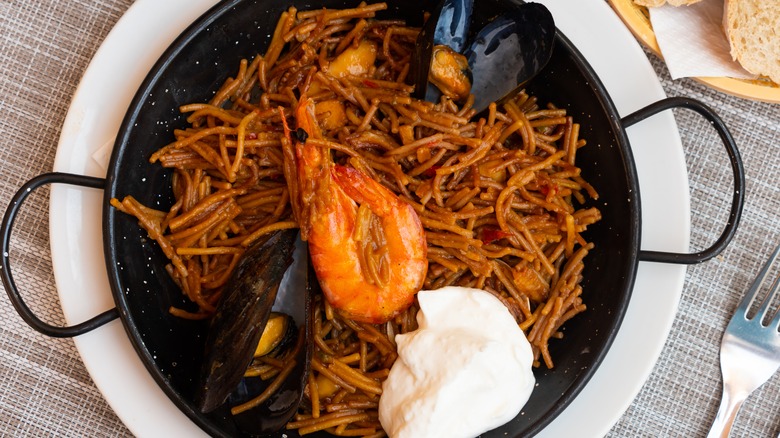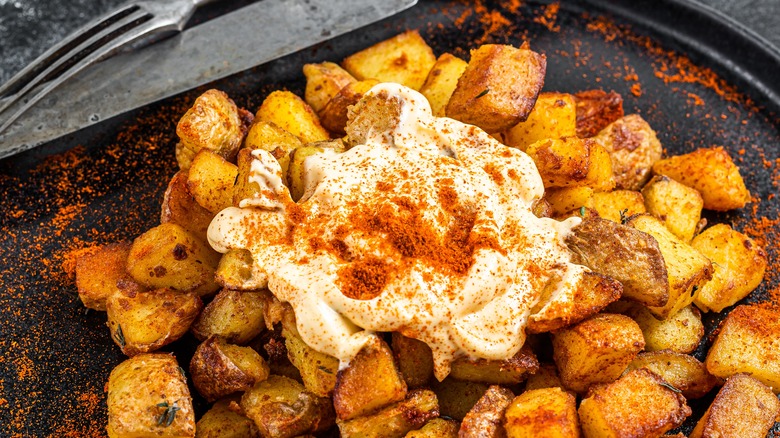Everything You Need To Know About Aioli
While mayonnaise may seem like a midwestern answer for anything food-related, aioli has recently made a name for itself as an upscale alternative, elevating any artisanal burger or gastropub side dish. Its versatility in use and flavor makes it the perfect candidate for almost any savory dish, from fish tacos to cauliflower steak. Dip it, drizzle it, smear it, spread it — to some, it may be reminiscent of a straightforward mayonnaise, but there is more to the emulsified sauce than meets the eye.
It may seem like aioli stepped into the scene and into our hearts in the early 2000s, but it has actually been around for thousands of years. Loved, worshiped, and enjoyed by cultures across the globe, mayo's fancy cousin has many faces, flavors, and varying recipes. Most likely, there are many facts you probably don't know about aioli; below is a breakdown of one of the most popular sauces in restaurants today.
The origins of aioli
Although it's not entirely clear when the first aioli recipe came about, it likely emerged from ancient times in the Mediterranean and Egypt, per Terres Dazur. This Lenten dish is quite simple, and the ingredients are extremely accessible and popular in those regions.
Chefin explains that aioli was most likely popularized in southern France or eastern Spain, noting it is a well-loved condiment in both regions to this day. The origin of the word, as described by Dictionary.com, breaks down "ai" to mean garlic, and "oli" means oil, the two primary ingredients.
Ancient Rome and Egypt enjoyed the sauce, and over the years it has developed into the delicious condiment that accompanies dishes around the world. In modern times, aioli can be found just about anywhere from grocery store shelves to upscale restaurants. Of course, you can also make aioli quite easily in the comfort of your home.
Aïoli Monstre or Le Grande Aioli
Few things are better than gathering around a table with loved ones to enjoy a family-style meal. So try "Le Grande Aioli," a celebration of the end of summer with a communal meal of boiled vegetables and steamed fish with a big bowl of aioli. As explained by The New York Times, the notion comes from traditions in Provence, intended to bring the community together, enjoy the finest flavors of the growing season, and dig into the year's garlic harvest.
The concept itself makes for a fantastic Mediterranean-style dinner, especially when you're not quite sure what to cook. Consider rounding up all your vegetables before they go bad, steaming or boiling them, adding a little steamed fish, and gathering the family around a big bowl of aioli. This not only makes for the perfect pescatarian meal, but can also solve the problem of a quick, simple last-minute dinner when unexpected guests arrive. Almost like a massive charcuterie board, this shared meal brings folks together around something delicious.
The key difference between aioli and mayonnaise
Wander into any gastropub, brewery, or artisanal burger joint and you're destined to find the word "aioli" on the menu more times than you can count. Often you can spot aioli smeared on your burger, drizzled on fries, or dolloped and ready for dipping. While it may seem like any flavored mayonnaise is an aioli, that is not the case.
There is actually a real difference between aioli and mayonnaise. Technically, flavored mayonnaise is simply mayonnaise with added aromatics, spices, or sauce while aioli is emulsified oil and garlic. At your average brewpub, hipster joint, or even upscale restaurant you will find that aioli is used as a blanket term. While it may upset top chefs, the word is frequently applied to what is essentially flavored mayonnaise.
Mayonnaise is typically made with canola oil and eggs, ingredients not found in a true aioli, per Webstraunt. While the two may seem interchangeable, and are used as such, their ingredients differ quite a bit. True aioli is hard to come upon these days — when in doubt, make your own.
How to make your own aioli
If you're looking for a traditional, mayonnaise-free aioli, it's likely you'll have to make it yourself. But cultures have been doing it by hand for centuries, so not only is it a way to connect to past cultures, but because of modern technologies, emulsifying the oil is made far easier than most of them ever had it.
There are a few simple techniques to make easy roasted garlic aioli. Start by oven-roasting garlic in its natural casing, slicing the very top off the head and drowning it in oil. Sprinkle with a little salt, and place on a baking sheet. After about 40 minutes at 375 degrees, the cloves should be soft enough to squeeze out of the head. When mashed, their texture will even resembles that of aioli. While the garlic roasts, whip together lemon juice and olive oil either by beating it quickly with a whisk or using an electric mixer. Add the garlic, and voila!
For an easier version, mix mayonnaise with lemon juice and roasted (or raw) pulverized garlic. This version is easier to make — which is likely why it is the one most commonly found in modern restaurants.
Is aioli vegan?
Can vegans consume aioli? Well, it largely depends on how strictly you define the term.
In the new wave of vegetarianism and veganism, the latter is largely defined as a philosophy and way of life that refuses to contribute to the harm or exploitation of animals (per Vegan Society). As such, animal products and by-products including meat, wool, honey, leather, milk, and eggs would not be permitted.
Because the majority of modern aioli is made with egg yolk, vegan aioli lovers are out of luck. But here's where things get interesting: Going back throughout history, traditional aioli was typically made with lemon juice, emulsified oil, and garlic. It was entirely free of animal products, and thereby vegan-friendly. So, if you want to kick it old school, aioli is your friend. But be careful to watch out for flavored mayonnaise-adjacent products.
The best way to know if the aioli you're about to consume is vegan is by reading the ingredients list, or asking your server.
International variations
A rich, creamy, fatty sauce can be tantalizing, so it's no wonder that similar sauces are adapted, tweaked, and popularized all over the globe. Although most international versions of aioli fall under the category of flavored mayonnaise, they were adapted from the original olive oil version.
For example, many products typically used on sushi, from spicy mayo to gochujang Korean hot sauce mayo to other variations of the creamy hot sauce are found all over Asia.
Flavored mayonnaise is used in recipes like elote (grilled Mexican street corn) south of the border, and in southern California, you'll find spicy aioli used in fish tacos. In Germany, you can find horseradish and mustard aioli popularly paired with bratwurst. Northern Africa has been eating aioli back to ancient Egyptian times, when they were accustomed to feeding large amounts of garlic to their slaves as they built the pyramids, giving them energy and strength.
France is well known for its use of the whipped garlic oil sauce — and of course, aioli is found in its original form all over the Mediterranean.
Tasty aioli variations
If you've traveled a bit, it's likely you've come across chipotle aioli, rosemary aioli, sriracha aioli, maple aioli, paprika aioli, and even the king of kings, truffle aioli. While garlic aioli is the OG, there are plenty of ways to change and enhance the flavor to pair perfectly with whatever it's being smeared on, dipped into, or drizzled on.
Iron Chef Jose Garces has a secret ingredient that he adds to his aioli. While it's the world's most expensive spice, per Business Insider, saffron takes aioli from amazing to unbelievable. This gives the aioli a sweet yet floral taste.
For a less expensive option, Andrew Zimmerman recommends adding fresh herbs like parsley and tarragon to his foolproof aioli. He believes these herbs round out the flavor, and pair beautifully with seafood.
Because Aoili has Mediterranean origins, it's no surprise that smoked paprika aioli is out-of-this-world delicious. The smokey flavor complements meats especially well — and also makes an incredible sandwich topping.
Unusal ways to use aioli
While aioli is typically smeared, drizzled, and dipped into, it makes for an incredible ingredient when added to recipes. For instance, aioli mashed potatoes with chives is something out of a culinary dream. It really can't get any more decadent.
Aioli was originally used as a vegetable and bread dip, so spreading it on toast to make garlic bread is an elite move that pulls pairings from its origins.
Consider mixing aioli into savory baked goods. Instead of using oil or butter in your savory baking, try using the far superior aioli. While it may seem like an odd concept to add a sauce to your french bread recipe, foccacia, or cheesy Mexican cornbread, it will certainly bring it to the next level of incredible.
In fact, any savory dish that uses oil or butter can be elevated with aioli. Mix it into your zucchini crab cakes, potato spring salad dressing, egg salad, or even homemade tortillas.
Use it as a dip
Since aioli has traditionally been used as a dip for centuries, it's no wonder that almost anything tastes incredible smeared with the whipped garlic sauce. Raw or roasted vegetables, fish, and bread often accompany the decadent delight, but it makes an incredible dip for pretty much anything.
Fried foods like crab cakes, fritters, french fries, zucchini fries, and fried chicken are happy to take the plunge into a saucer of creamy aioli. Just when you thought you couldn't get enough oil, eh?
Roasted vegetables, fresh bread, crackers, and even chips are great options when it comes to dipping into the whipped oil. Add it to your next charcuterie board, or put it out on game night. When in doubt, potatoes can always be dipped into aioli, whether they are fried, baked, boiled, grilled or roasted. In fact, crispy potatoes with saffron aioli should really make an appearance at your next meal.
Smear it on a sandwich
Any sandwich can be drastically elevated using the allure of aioli. In fact, since aioli pairs well with any meat, fish, or vegetable, it could be considered the perfect condiment.
In addition, whatever existing condiments you decide to spread on your sandwich can be enhanced with aioli. Ketchup, mustard, horseradish, barbecue sauce, and any dressing can be mixed with aioli to create an additional layer of depth and richness. Try topping your roast beef sandwich with horseradish aioli. Spread honey mustard aioli onto your turkey club. Mix ketchup and aioli to create the ultimate fancy sauce for your burger. Enhance your classic blackened fish sandwich with lemon dill aioli.
If your sandwich just isn't quite saucy enough, serve it with some aioli for dipping. The truth is, you really can't ever get enough of the stuff. And let's be real, a good sandwich should be dripping with sauce. A messy sandwich is a legendary sandwich.
Spread it on tacos
The beauty of tacos is that each corn pocket contains so many different flavors and textures. The crunch of the shells matches the chewiness of charred meat. The juicy diced tomatoes pair beautifully with the crunchy, bitey onions. The sweet sauces balance out the spicy peppers.
That's why a sauce that can hold many flavors is a taco's best friend. Aioli can be sweet, spicy, tangy, and salty all at once. There's a reason that crema, avocado sauces, and sour cream are often found atop the Mexican dish. The creaminess helps balance the sharp and spicy flavors, leaving a rounded mouthfeel.
But it's no fair to let fish tacos have all the fun when it comes to the aioli game. Although chipotle lime aioli is commonly found drizzled on southern Californian fish tacos recipes, any taco can be elevated with the elite sauce.
Try black bean tacos with sriracha aioli, or carnitas tacos with cilantro aioli. Even tacos el pastor can be elevated with spicy pineapple aioli or pepper lime aioli.
Drizzle it on a grain bowl
Grain bowls are all the rage, and for a good reason. They are hearty, generally healthy, easy to adapt, and of course, delicious. Poke bowls, buddha bowls, and grain bowls alike have made their way onto menus across America, and we are here for it.
There are several main elements that go into the creation of a standard grain bowl. First is the cooked grain of choice, ranging from brown rice and quinoa to barley and farro. Once you have a solid foundation down, vegetables are typically the next addition. They can come cooked raw, or a mixture of both. Not always, but sometimes meat or fish are added. The biggest mistake commonly made with grain bowls is not putting enough emphasis on the sauce and toppings: seeds, dressings, soy sauce and more.
For a poke bowl, spicy aioli (like sriracha aioli with lime) makes a near-perfect addition. For a buddha bowl, a citrus garlic aioli complements the mild flavors of the vegetables well, adding a little punch of flavor.
Pair it with seafood
Both garlic and lemon are beloved companions of seafood, so it's no wonder that aioli pairs well with it too. Mayonnaise and tartar sauce is often used alongside baked salmon, crab cakes, and fish sticks. Le Grande Aioli traditionally contains elements of steamed fish, so this natural pairing has been around for centuries.
Pair with your standard lemon garlic aioli, or try adding fresh herbs like parsley, cilantro, or dill. Try tarragon, horseradish, or even paprika. Mix the aioli right into classic Maryland crab cakes, or slather them onto your grilled salmon recipe before baking. Consider mixing it with capers, and adding sliced lemon to complement the delicate fish. Finger food like fish sticks can be dipped right into the aioli after cooking. All in all, the basic lemon and garlic flavors work well with mild seafood, so when in doubt, stick with old reliable.
Drizzle over potatoes
Potatoes are meant to be paired with aioli, there are no two ways about it. Those dense spuds are just about the most versatile food on the planet. From french fries to hash browns to baked potatoes to mashed, it's hard to not love a good ol' potato. It's the starch that keeps on giving, and because they are extremely low in fat, they love being dipped into aioli.
If you've been dipping your french fries into ketchup alone, you're doing it wrong. Try putting a dish of aioli alongside, and work the two sauces together next time. You'll never go back.
The fried Spanish potato dish you must try at least once is patatas bravas, and it delivers. With perfectly spiced fried potato cubes, the slathering of aioli on top just adds to the excitement. Take a tip from the Spanish and leave no potato without its aioli counterpart.
